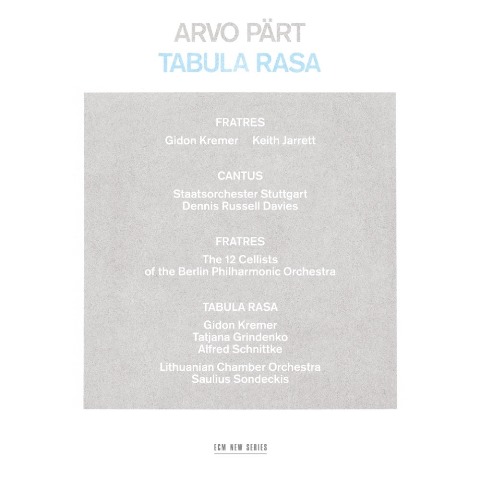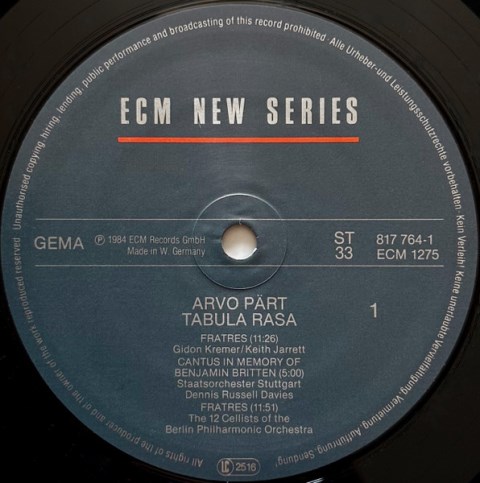Music Reissues Weekly: Arvo Pärt - Tabula Rasa | reviews, news & interviews
Music Reissues Weekly: Arvo Pärt - Tabula Rasa
Music Reissues Weekly: Arvo Pärt - Tabula Rasa
A foundational album returns

In 2022, Spritualized’s Jason Pierce described his musical goal as "trying to find somewhere between Arvo Pärt and The Stooges.” Amongst the most arresting and explicitly Pärt-styled results of this quest to link the minimalist composer with Iggy Pop‘s pre-punk confrontationists was the affecting "Broken Heart," from his band’s 1997 third album Ladies And Gentlemen We Are Floating In Space.
Pierce hasn’t been alone in declaring a fidelity to Pärt. In 2009, former Public Image Ltd bassist Jah Wobble cited Pärt as his choice of Sunday morning music. He was moved to tears while listening. In 2005, Arcade Fire's Regine Chassagne said she was also a devotee. Swans members Michael Gira and Jarboe said, respectively, that “Arvo Pärt’s music is really important” (2012) and “you cannot go wrong with Arvo Pärt. All his compositions, the entire body of recordings – I cannot recommend them enough – they are so sophisticated and minimalist, they have a sense of restraint in which everything has a meaning” (2019). The Danish singer-songwriter Agnes Obel said Pärt creates “music beyond cynicism. Deeply beautiful in a way that to me sounds almost spiritual” (2014). PJ Harvey and David Sylvian are amongst the others who have also lauded Pärt.
 If an admiration for Pärt wasn’t made explicit, arguments were made that his presence could be implicit. Back in 1994, a Melody Maker review of Aphex Twin’s Selected Ambient Works Volume II said a track “recalls the devotional music of minimalist composers like Arvo Pärt; its restrained, elegiac grandeur creates a paradoxical effect, a sort of thunderous hush."
If an admiration for Pärt wasn’t made explicit, arguments were made that his presence could be implicit. Back in 1994, a Melody Maker review of Aphex Twin’s Selected Ambient Works Volume II said a track “recalls the devotional music of minimalist composers like Arvo Pärt; its restrained, elegiac grandeur creates a paradoxical effect, a sort of thunderous hush."
The flow of acclaim for a previously niche-interest Estonian composer began after the September 1984 release on CD and LP of Tabula Rasa. It was the first album on a discrete ECM offshoot imprint dubbed “ECM New Series” – a label dedicated to composed works, those with written notation, and recordings which did not naturally slot into ECM’s trajectory as a (nominally) jazz label. Nonetheless, ECM mainstay Keith Jarrett played on Tabula Rasa. The album featured two arrangements of Pärt’s “Fratres” (for violin and piano, and for 12 celli), “Cantus in Memory of Benjamin Britten” and the two-movement “Tabula rasa” (“Ludus” and “Silentium”). The hyperbolic essay included in the package declared “At times, Arvo Pärt’s compositions are like the hesychastic prayers of a musical anchorite; mysterious and simple, illuminating and full of love.”
Tabula Rasa is reissued on vinyl for its 40th anniversary. Mint copies of a first press of the original album sell for at least £170 (the label of which is pictured here). In comparison with a 2010 CD version, this new edition is almost totally noise free (when played back at great volume on Bayer headphones) and is more dynamic. The separation between instruments is greater, and what’s heard feels closer. More alive. This new package is as per the 1984 album, including Wolfgang Sandner’s benchmark essay. The reissue is marketed as a “limited edition” but, frustratingly, the amount pressed is not specified. The music still sounds great: grand yet direct.
 At the point Tabula Rasa was issued, Pärt was no longer resident in Estonia. Then, it was still under Soviet occupation. He had left in 1980. Before this, “Tabula rasa” was composed in 1977. It was first performed in the Estonian capital Tallinn that year. “Cantus in Memory of Benjamin Britten” and versions of the “Fratres” were first performed in Austria in August 1980 but were composed in 1976 or 1977. The nature of these pieces drew from Pärt’s idea of “tintinnabulation:” a music constructed from single notes. A maximalist approach to minimalism. In this, curious as it is, Pärt was not far from the ethos of 1969’s first Stooges LP.
At the point Tabula Rasa was issued, Pärt was no longer resident in Estonia. Then, it was still under Soviet occupation. He had left in 1980. Before this, “Tabula rasa” was composed in 1977. It was first performed in the Estonian capital Tallinn that year. “Cantus in Memory of Benjamin Britten” and versions of the “Fratres” were first performed in Austria in August 1980 but were composed in 1976 or 1977. The nature of these pieces drew from Pärt’s idea of “tintinnabulation:” a music constructed from single notes. A maximalist approach to minimalism. In this, curious as it is, Pärt was not far from the ethos of 1969’s first Stooges LP.
However, that unlikely association is not what brought him into the non-classical consciousness. The ensuing pair of ECM New Series albums to arrive in shops in 1984 after Tabula Rasa were John Adams’ Harmonium and the Bruno Ganz poetry set Hölderlin. Taken together, the trio did not suggest a specific identity for ECM New Series, but it was quite clear with Tabula Rasa – through the tone of Sandner’s liner notes and the enigmatic nature of the photographs of Pärt used for the album – that a form of marketing was being undertaken. Pärt’s faith, and that his music reflected it, were telegraphed.
Aligning the power of the music with a clearly defined identity meant buyers instantly had a sense of Arvo Pärt; and that he and his music were one. In time, awareness increased, Pärt’s name cropped up more and more often. It is now hard to hear Tabula Rasa without the ensuing context which has evolved; to hear it afresh. For anyone who fancies listening to Tabula Rasa as music rather than part of a continuum, this handsome reissue fits the bill.
- Next week: Rain’s Tomorrow Never Comes - The NYC Sessions 1967–1968. Chronicling the extraordinary transformation of Merseybeat band The Undertakers into a US-based psych-pop outfit
- More reissue reviews on theartsdesk
- Kieron Tyler’s website
Share this article
The future of Arts Journalism
You can stop theartsdesk.com closing!
We urgently need financing to survive. Our fundraising drive has thus far raised £49,000 but we need to reach £100,000 or we will be forced to close. Please contribute here: https://gofund.me/c3f6033d
And if you can forward this information to anyone who might assist, we’d be grateful.

Subscribe to theartsdesk.com
Thank you for continuing to read our work on theartsdesk.com. For unlimited access to every article in its entirety, including our archive of more than 15,000 pieces, we're asking for £5 per month or £40 per year. We feel it's a very good deal, and hope you do too.
To take a subscription now simply click here.
And if you're looking for that extra gift for a friend or family member, why not treat them to a theartsdesk.com gift subscription?

Add comment